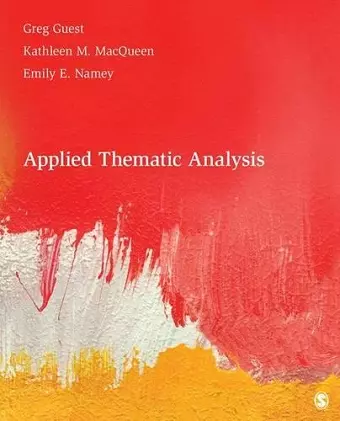Applied Thematic Analysis
Greg Guest author Kathleen M MacQueen author Emily E Namey author
Format:Hardback
Publisher:SAGE Publications Inc
Published:10th Jan '12
Should be back in stock very soon

After collecting qualitative data from in-depth interviews, focus groups, or field observations, students and researchers often struggle to make sense of it. This step-by-step guide draws on the authors′ many years of experience carrying out qualitative research and conducting trainings on the subject. Their book describes how to analyze qualitative data in a systematic and rigorous way. The authors introduce and outline applied thematic analysis, an inductive approach that draws on established and innovative theme-based techniques suited to the applied research context. Chapters follow the sequence of activities in the analysis process and also include discussions of mixed methods, choosing the most appropriate software, and how to write up and present the results.
"This book presents what all of the books I′ve tried to use in the past have failed to present—how to analyze qualitative data."—Catherine C. Schifter, Temple University
"This book does a wonderful job of explaining how important thematic analysis is for producing good research, and it uses rich and detailed examples to do it."—Matthew Hartley, University of Pennsylvania
“There are few qualitative texts that really present a step-by-step process of how to analyze qualitative data in a systematic and rigorous way. It is very well written, students will find this text helpful. The examples are great.” -- Howard K. Butcher
“I like that it is practice focused. The real world examples are key and the real world problems make the text more useful. The exercises are nice to pick from for in-class activities or small projects.” -- Natoshia M. Askelson
I really think that this is the book that was very much needed. Thematic analysis in my experience is one of the most popular techniques that students use in their dissertations, but there has been little written about methodological foundations and the actual process and procedures of this kind of analysis. I think this book fills this gap very well and provides the description of actual analytical techniques to make the process more structured and rigorous. The book also incorporates examples from NVivo which is a very popular software with many institutions at the moment. The second section is about quantifying qualitative findings – and integrating quantitative and qualitative data. I find the description interesting and there are a couple of very useful tables and classifications of how to do it which no doubt will be useful for students. The section on writing up findings is really useful and I think can be used as a teaching material even if one is not using thematic analysis. Overall the book is very good and I would definitely recommend it to students on Dissertation Writing modules and/or PG Research Methods. -- Maria Karepova
ISBN: 9781412971676
Dimensions: unknown
Weight: 710g
320 pages